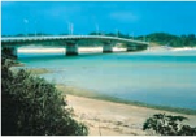Travel Reference
In-Depth Information
The bridge connecting Ōjima to Yagaji.
Whatever your sentiments on visiting a “dead” island, soon enough, in less than half a
mile (less than a kilometer), you're off, for the bridge to the next island, connecting Ōjima to
Yagajijima, comes straightaway.
12
YAGAJIJIMA
屋我地島
We'll next cross on to the island of Yagajijima (
屋我地島
; Yagaji-jima). Its southernmost point
is connected to the northernmost tip of Ōjima by a 985-foot (300-meter) bridge. Yagaji is not
very regularly shaped. It's probably best to say that it is a little longer than 2.5 miles (4 kilo-
meters) from north to south at its greatest length and about 1.75 miles (3 kilometers) across
from east to west at its widest. Its total surface area over its most irregular shape has been
calculated at 3 square miles (7.81 square kilometers). No part of it is very high, and indeed
its low profile helps make it a fully cultivated agricultural islet.
In fact, it's so well developed and there are so many roads criss-crossing the island that it's
easy to get lost while driving around. Virtually every square foot of this islet is fully exploited
and everywhere you turn there is a farm of one sort or another growing all manner of exotic
crops. You'll see aloe cactus, bird-of-paradise flower farms, chrysanthemums and, of course,
sugar cane and other crops.
Up until only a few years ago Yagaji was a dead end, literally and figuratively. Once you
turned west on to the island from Route 58 on Okinawa Main Island (and crossing over
Ōjima), there was no place to go other than to circle around the islet and return via the same
way you entered. Perhaps this isolation had something to do with the placement of the Na-
tional Sanatorium Okinawa Airakuen (
国立療養所沖縄愛楽園
; Kokuritsu Yoryojo Okinawa
Airakuen), a Hansen's Disease-leprosy colony. For it is here, at the north-easternmost point
of the islet, that the colony was established in the early part of the 20th century. The number
of residents at the sanatorium has varied over the years, from close to 1,000 in the post-World
War II period to as few as several hundred today.


